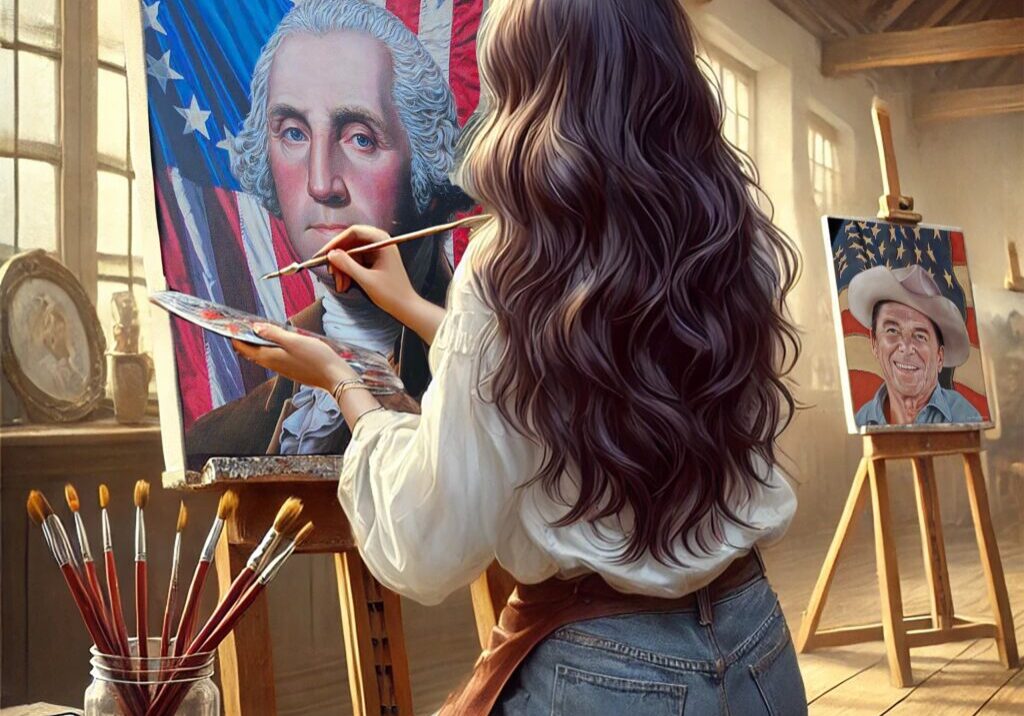
Shadow and Flame: Painting Light into the American Story
Light is more than brightness on a surface. In painting, it’s emotion. It’s timing. It’s memory. When I work on a mural like this – spanning decades, lives, and causes – I don’t use light just to show form. I use it to carry the story. Where the light falls, and where it doesn’t, changes how we feel about a moment. It can lift a figure into hope or bury a truth in silence. Every glow and shadow in the 250th Anniversary Mural is a choice. I never treat light as neutral.
A sunrise is not just a sunrise – it’s promise, it’s tension, it’s foreshadowing. A candle isn’t just a candle – it’s resistance, secrecy, fragility. I often work with layered glazes to build the light slowly. That gives it texture and breath. In the Unity section, warm light pools around conversations and shared labor. In the Freedom section, it sharpens – harsher contrasts, longer shadows, sharper edges. By the time we reach Progress, the light starts to stretch again – soft, atmospheric, open. Shadow is its own kind of language. I use it to quiet a scene or complicate it.
A figure half-lit might be undecided. A document in shadow might still be dangerous. When I paint shadow over a protest symbol or print, I’m reminding the viewer that this idea – once public – was pushed underground. I let some details disappear in the dark not to hide them, but to give them weight. What we can’t fully see still shapes how we look. Light also gives rhythm to the eye. In a large-scale mural, it’s easy to get lost in the detail. So, I use pockets of light like steppingstones. They guide the viewer through the story, from one emotional beat to the next.
A glint on metal, a shaft of light through a window, a glow on a child’s cheek – these are quiet beacons. They aren’t loud, but they say, look here. Feel this. One of my favorite techniques is using light to suggest time. In some panels, the light is crisp and frontal, like mid-morning. In others, it comes low and raking, like the last hour of the day. Time of day changes the emotional temperature of a scene. It says whether a moment is opening or closing, rising or resting.
That helps the viewer feel the flow of history, not just observe its structure. Color temperature plays a big role. My warm lights carry orange, amber, and gold – tones that evoke firelight, candlelit rooms, or early sun. They feel human, intimate. My cooler lights lean toward silvery blue or soft gray. These I use in moments of tension or waiting. They add restraint. They hold the breath of the scene. I rarely use pure white. Too much clarity flattens the experience. I want the light to glow, not glare. Reflected light is one of the most powerful but overlooked tools in my process. In some scenes, it bounces off the back of a page, or off the fold of a garment, illuminating what would otherwise be overlooked.
This gives me a chance to honor details quietly – to make them felt before they’re fully seen. In this way, the light becomes a collaborator. It reveals things at its own pace. In the mural’s darkest corners, there is always something catching a sliver of illumination. A dropped letter. A clenched hand. The eyes of someone listening. These moments remind us that the Revolution was not just made in parades and proclamations. It was also made in dim spaces, in hard decisions, in whispered truths.
The light tells us what to remember. The shadow reminds us of what was risked. I don’t paint light to flatter. I paint it to speak. And when it’s working well, it doesn’t just show the scene. It becomes part of the emotion – of the history itself. That’s the story I want to tell. Not just what happened. But how it felt to stand there, in the flicker and the flame.

